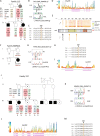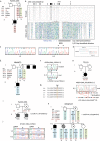Skewed X-chromosome inactivation in unsolved neurodevelopmental disease cases can guide re-evaluation For X-linked genes
- PMID: 36879111
- PMCID: PMC10620389
- DOI: 10.1038/s41431-023-01324-w
Skewed X-chromosome inactivation in unsolved neurodevelopmental disease cases can guide re-evaluation For X-linked genes
Abstract
Despite major advances in genome technology and analysis, >50% of patients with a neurodevelopmental disorder (NDD) remain undiagnosed after extensive evaluation. A point in case is our clinically heterogeneous cohort of NDD patients that remained undiagnosed after FRAXA testing, chromosomal microarray analysis and trio exome sequencing (ES). In this study, we explored the frequency of non-random X chromosome inactivation (XCI) in the mothers of male patients and affected females, the rationale being that skewed XCI might be masking previously discarded genetic variants found on the X chromosome. A multiplex fluorescent PCR-based assay was used to analyse the pattern of XCI after digestion with HhaI methylation-sensitive restriction enzyme. In families with skewed XCI, we re-evaluated trio-based ES and identified pathogenic variants and a deletion on the X chromosome. Linkage analysis and RT-PCR were used to further study the inactive X chromosome allele, and Xdrop long-DNA technology was used to define chromosome deletion boundaries. We found skewed XCI (>90%) in 16/186 (8.6%) mothers of NDD males and in 12/90 (13.3%) NDD females, far beyond the expected rate of XCI in the normal population (3.6%, OR = 4.10; OR = 2.51). By re-analyzing ES and clinical data, we solved 7/28 cases (25%) with skewed XCI, identifying variants in KDM5C, PDZD4, PHF6, TAF1, OTUD5 and ZMYM3, and a deletion in ATRX. We conclude that XCI profiling is a simple assay that targets a subgroup of patients that can benefit from re-evaluation of X-linked variants, thus improving the diagnostic yield in NDD patients and identifying new X-linked disorders.
© 2023. The Author(s), under exclusive licence to European Society of Human Genetics.
Conflict of interest statement
The authors declare no competing interests.
Figures



